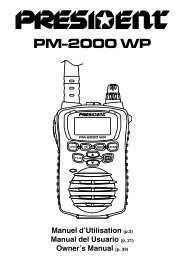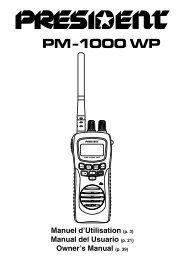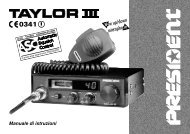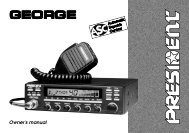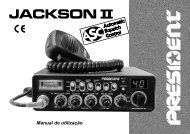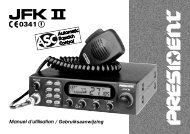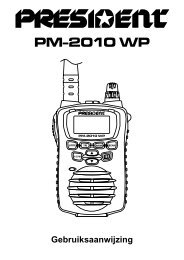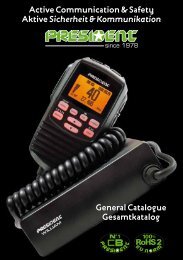MC 6800 DSC - President Electronics
MC 6800 DSC - President Electronics
MC 6800 DSC - President Electronics
You also want an ePaper? Increase the reach of your titles
YUMPU automatically turns print PDFs into web optimized ePapers that Google loves.
The <strong>MC</strong> <strong>6800</strong> <strong>DSC</strong> requires a 12v DC supply to operate, This lead should be connected to<br />
the vessel’s power supply, keeping the cable runs as short as possible. Although the radio<br />
draws very little current when receiving, a heavier current is drawn when transmitting which<br />
may result in a voltage drop if very long cable runs are used of inadequate core diameter. If<br />
the supplied power lead is not long enough, an extension of up to 3m(10 ft)can be made<br />
using at least 2.5mm (13AWG) wire.<br />
The chassis of the Radio is not connected to either supply rail. This allows a direct connection<br />
to the ship’s earth connection for voltage and RF interface protection. The red wire is<br />
positive and black is negative. If polarity is accidentally reversed, the set will not operate.<br />
The antenna is connected to the radio using a standard PL259 type connector as fitted to<br />
most marine antennae. If fitting to an existing antenna, check that the contacts are not corroded<br />
before connecting, as this will affect the quality of the signal, Ensure that the retaining<br />
collar of the antenna plug is securely tightened to prevent accidental disconnection.<br />
3. Antenna Installation Recommendations<br />
The most important factor in the performance of the <strong>MC</strong> <strong>6800</strong> <strong>DSC</strong> radio will be the quality<br />
and positioning of the antenna. Most recorded problems with VHF radios are related to poor<br />
antenna siting, faulty cabling, poor quality cable joints and low voltage supply. Therefore, if<br />
replacing an existing if installation, it is important that these factors are checked when installing<br />
the radio.<br />
As the range of VHF signals are governed by line of sight, the antenna should be placed as<br />
high as possible, while remaining clear of any metallic objects that could influence the radiation<br />
of the antenna.<br />
The most popular antennae for marine use are 1m(3ft 3in) long. On sail boats these are<br />
usually mounted on the masthead, where the length of the antenna keeps it clear from the<br />
navigation lights and wind vanes etc. This type of antenna can also be mounted on the<br />
cockpit roof or garage of powerboats.<br />
Longer whip antennae are recommended for larger boats. These radiate the same total power<br />
as smaller antennae, but concentrate it into a narrower beam, which is advantageous on a<br />
tall mast at extreme range where concentrating the available power into a narrow horizontal<br />
beam becomes more important. However, if the antenna is mot vertical when transmitting,<br />
the beam will be angled either too high or too low (Fig G). Here the wider beam of the shorter<br />
antenna will be more universally effective, although the signal will be weaker (Fig F):<br />
Therefore vessels with a large heel angle (small sailboats)would be better choosing a short<br />
masthead antenna. Your local agent should be able to provide specific advice on antenna<br />
choice for the vessel it is to be fitted to.<br />
The antenna coaxial cable and any connectors used must be rated at 50¦¸.Under no circumstances<br />
should standard domestic TV cable and connectors be used. Incorrectly rated cabling<br />
and connectors could result in power not reaching the antenna, but also power could be<br />
reflected back into the radio, damaging it in the process.<br />
48



